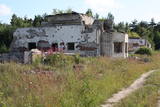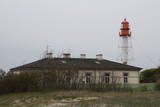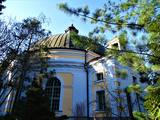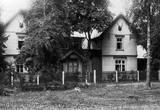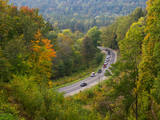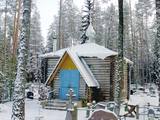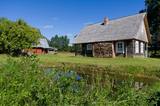| Nr | Nosaukums | Apraksts |
|---|---|---|
|
Grigaļciemā daļēji sagabājies vairāku ēku kompleks, par kura kādreizējo pielietojumu trūkst informācijas. Ēkas jauktas un izmantotas būvmateriāliem. Ja paskatās dabā un aerofotogrāfijās, redzams, ka militāriem mērķiem ir izmantota daudz lielāka teritorija, kā kartē atliktais punkts, jo ziemeļos un rietumos no tās atrodas bijušie tanku (?) poligoni. Arī ceļa malā, kas ved uz jūru redzamas pamestas militārās būves.
|
||
|
Padomju laikā visas bākas bija militāra statusa objekti, arī Papes bāka. Šobrīd bāku apsaimnieko Latvijas Jūras administrācija un tā ir apskatāma tikai no ārpuses.
|
||
|
Uzņēmums strādā jau vairāk kā 20 gadus un sadarbojas ar ~ 100 vietējiem piena ražotājiem. Tā galvenais darbības princips ir dabīgu un veselīgu piena produktu – kefīra, biezpiena, krējuma, jogurta un mīksto sieru ražošana. SIA „Elpa” ir vienīgais Dienvidkurzemes piena pārstrādes uzņēmums, kas piedāvā ekskursijas un produkcijas degustāciju. Produktus var iegādāties arī uz vietas. Ekskursijas laikā var degustēt kefīru, sieru, jogurtu, kā arī ir iespēja pašiem darboties. |
||
|
Ir atrodamas ziņas, ka baznīca šajā vietā atradusies 17. gadsimtā. Mūsdienās redzamais dievnams ir celts laikā no 1792. – 1794. gadam. Kupolveidīgās celtnes projekta autors bija Rīgas pilsētas galvenais būvmeistars Kristofers Hāberlands. Kupola forma nodrošina labu akustiku iekštelpās. Altāris izvietots pret ieejas durvīm. Starp ēkas kolonnām ir novietota altārglezna, kas attēlo Kristu un Pēteri viļņos apņemtajā jūrā. Kā nozīmīgi interjera priekšmeti jāmin 18. – 19. gs. vīna kausi, svečturi u.c. 2014. gadā ēka restaurēta. Dienvidos no baznīcas atrodas Katlakalna kapi, kuros apglabāts ievērojamais vācbaltu rakstnieks un publicists Garlībs Merķelis (1769. – 1850.), kuram bija nozīmīga loma dzimtbūšanas atcelšanai Baltijā. Katlakalna ev.lut. baznīcas jau vairāk nekā 200 gadus slejas varenu priežu audze, kuras taciņas aizvedīs līdz pat Daugavai, no kuras krasta var palūkoties uz Rīgas TV torni. |
||
|
Seto Tsäimaja, kas pieder pie Setu muzeja, var baudīt ēdienus no setu tradīcijās gatavotiem māla traukiem, klausīties setu dziesmas un instrumentu spēli. |
||
|
Netālu no augstākā Latgales augstienes paugura – Lielā Liepukalna atrodas zemnieku saimniecība, kuras darbnīcā amatnieks Jānis Kuzminskis taisa mūsdienīgas ģitāras u.c. mūzikas instrumentus. Apmeklētāji var iepazīt Jāņa veidoto ekspozīciju, vērot amatnieka darbošanos, pasūtīt sev jaunu instrumentu, kā arī muzicēt pie bagātīgajā kolekcijā savāktajiem instrumentiem. Saimniece stāsta par Latgales kulinārā mantojuma ēdieniem un rāda, kā gatavo gulbešnīkus. |
||
|
Redzama jau pa lielu gabalu no abiem Daugavas krastiem. Baznīcu cēla 1909. - 1913. gadā. Kā interesants ir jāmin fakts, ka tās būvniecībā izmantoto sarkano ķieģeļu kvalitāte bijusi slikta, tādēļ kopš 1939. g. ir nomainīti ap 60 000 ķieģeļi! Neskatoties uz to, dievnams ir nominēts kā viena no iespaidīgākajām Latvijas sakrālajām celtnēm. Tās būvniecībā pielietoti neogotikas stila dekoratīvie elementi, bet interjera iekārtas - altāris, kancele, ērģeļu luktas, baznīcēnu soli un mūsdienās izgatavotie biktssoli ir veidoti gotiskās formās. Ērģeles būvētas 1931. gadā. Baznīca cieta 1. pasaules kara laikā un to atjaunoja 1921. g. To ieteicams apmeklēt gida pavadībā. |
||
|
Trīs lielāka izmēra laukakmeņi – aizsargājami dabas pieminekļi, kas atrodas Matsalu līča krastā starp Sāstnas (Saastna) un Metskjulas (Metsküla) ciemiem. Tuvējā ceļa malā ir izvietots informācijas stends un norādes, bet līdz akmeņiem var nokļūt pa iezīmētu taku. Pēc kāda tautas nostāsta, lielas vētras laikā, kas notikusi Jaungada naktī, lielais akmens sašķēlies trīs daļās. No tā arī cēlies vietvārds. Apkārtnē redzamās pļavas ir nozīmīga daudzu augu sugu dzīves vide un svarīga putnu ligzdošanas un atpūtas vieta. Šī iemesla dēļ taku drīkst apmeklēt tikai no 1. jūlija līdz septembra beigām. Akmeņi ir arī labi redzami no minētā ceļa. Tie ar ledāju atceļojuši no Turku (Somija) apkārtnes. |
||
|
Agrākais mājas nosaukums bija „Forstei” (tulkojumā nozīmē mežziņa māja). Tā celta, izmantojot vecās Bīriņu pils baļķus. Ēkas pirmais īpašnieks bija Bīriņu muižas barons Aleksandrs Aleksejs fon Pistolkorss. Tajā dzīvoja muižas virsmežzinis Pauls Moltrehts, vienlaicīgi tā bija virsmežziņa darba, dzīves vieta un muižas medību māja. Ēka vairākkārt pārbūvēta. Līdzīgu izskatu patreizējam un arī simboliskos brieža ragus tā iegūst 1891. gadā. Neatkarīgās Latvijas laikā mājai tika latviskots nosaukums – „Meža māja”. Vairākkārt mainījušies arī tās īpašnieki. 30. gados tā kļūst par kultūras un mākslas darbinieku atpūtas mītni. Šeit 1937. gadā vasaru pavadīja komponists Alfrēds Kalniņš, strādājot pie pirmās latviešu operas “Baņuta” partitūras interpretācijas otrajam iestudējumam. Pēckara periodā No 1945.gad līdz 1956. gadam ēkā atradās Saulkrastu Ciema Padome, Saulkrastu rajona laikā Tautas izglītības nodaļa. Pēc tam uz ēku no Jūrmalas tika pārcelta bērnu sanatorija „Ugunskurs”, kura vēlāk pārdēvēta Saulkrastu vārdā. Šobrīd ēka ir privātīpašums. (Avots: Saulkrastu TIC) |
||
|
Lielākais japāņu dārzs Eiropā (16 ha) sāka veidoties 2007. gadā. Dārzu izveidoja japāņu meistars Hajime Watanabe un ārsts Šarūns Kasmauskas, apvienojot reliģiju, mākslu un godbijību dabai. |
||
|
Atrodas Skuķu ezera ziemeļaustrumu krastā. No torņa labi saskatāms aizaugušais Skuķu ezers ar nelielām ūdens lāmām un ūdeņiem bagātos pavasaros pārplūstošā Dvietes paliene. Laba putnu vērošanas vieta. |
||
|
Cafe Vizbuļi atrodas Bērzciemā, Engures novadā, apmeklētājiem piedāvā nobaudīt gardu maltīti, svaigi ceptas smalkmaizītes, izbaudīt Bērzciema jūru, atpūsties un relaksēties. Ziemas sezonā kafejnīca atvērta tikai nedēļas nogalē, vasaras sezonā - katru dienu, ir āra terase. |
||
|
Arī 18. novembra laukums. Tas sācis veidoties 18. gadsimtā kā tirgus laukums. Tā dominantes bija 1752. g. celtais rātsnams (nav saglabājies) un aptieka, kas šajā ēkā darbojas no 1810. g. līdz pat mūsdienām. 2010. gadā laukumā izveidota strūklaka, kam ir pilsētas ģerboņa forma. |
||
|
Baltijas ceļš bija unikāla akcija ne vien Baltijas, bet visas Eiropas un pat pasaules mērogā. Nekad vēl nebija bijis tā, ka triju valstu iedzīvotāji vienotos dzīvā dalībnieku ķēdē, kura savienoja valstu galvaspilsētas – Viļņu, Rīgu un Tallinu. Vēsturiskais notikums noritēja 1989. gada 23. augusta vakarā, tas vienoja apmēram 2 miljonus cilvēku. Tā mērķis bija pievērst uzmanību un atgādināt 50 gadus vecus notikumus – Ribentropa – Molotova pakta noslēgšanu. Tā rezultātā divas tā laika lielvaras - Vācija un PSRS pārdalīja ietekmes sfēras Eiropā pirms kārtējā pasaules kara, bet Baltijas valstis zaudēja savu neatkarību. |
||
|
Maltas (Rozentovas) Visusvēto pareizticīgo baznīca uzcelta
1928. gadā. Tā ir koka guļbūve ar dubultiemlogu rāmjiem un sīpolveida
kupolu, fasādēs – stilizēts saules motīvs.
|
||
|
Liela meža masīva vidū gleznainās Būkas (Būka) upes krastos starp kokiem ieslēpies teiksmainais Vaišnoriškes ciems. Šis ir viens no skaistākajiem nacionālā parka etnogrāfiskajiem ciemiem. Vaišnoriške kā apdzīvota vieta sākusi veidoties 1756. g., kad šeit sena vēsturiska ceļa malā darbojies krogs. Pirmā viensēta ciematā ir zināma no 1830. g. Šodien redzamā apbūve ir tapusi g.k. 20. gs. sākumā. Ciems ir palicis cilvēku atmiņās ar liepu medu, jo meža velšu vākšana un biškopība bija viena no galvenajām šejieniešu nodarbēm. Tagad ciemā ir piecas sētas. No Vaišnoriškes var uzsākt laivu braucienu pa seklo un dzidro Būku. |
||
|
Saimniecībā, kas atrodas Raunas upes krastā, audzē dažādas zivju sugas. Ziemas piedāvājumā ir dažādu lašveidīgo zivju makšķerēšana, bet vasarā var makšķerēt stores, sīgas, tilapijas un foreles. Sillakās var arī iegādāties zivis, bet apmeklētāju grupām sagatavo zivju degustāciju. Sillakas atrodas ~ 3 km no Liepasmuižas. |
||
|
Mācību drava piedāvā piedzīvojumu bišu dravā - ieraudzīt, sajust, sagaršot, sadzirdēt. Apmeklētājiem ir iespēja iepazīt dravnieka arodu (no maija līdz novembrim), izbaudīt veselības kūri (no maija līdz augustam - trešdienās un sestdienās) un degustēt bišu našķus, drosmīgajiem - īpaši pārsteigumi. Organizē meistarklases "Sveču gatavošana", "Vaska gleznas", "Gardēdis", "Veselība no bišu dravas", "Jaunais biškopis", kā arī praktiskas apmācības un seminārus biškopjiem. |
||
|
Dabas un meža ieskauta lauku māja ar 4 h lielu teritoriju atpūtai laukos. Caur pagalmu tek upīte Nova. 3 km attālumā atrodas Novaraisčio ornitoloģiskajā rezervātā. Rezervāta mitrājos dzīvo simtiem dzērvju. Ik rītu tās lido virs mājas un vakarā kliegdamas atgriežas. Plaša zaļā zona piemērota dažādu pasākumu rīkošanai. Iespējama nakšņošana teltīs. Īpaši gaidītas ģimeneS, kas novērtē senās lietuviešu tradīcijas. |
||
|
Taisnā Celtnieku iela ir bijušās Liepājas – Aizputes šaursliežu dzelzceļa (celta 1900. gadā, 49 km gara) līnijas „trase”, kuras malā (Celtnieku ielā 50) redzama bijusī dzelzceļa stacijas ēka. |
||
